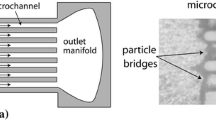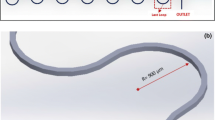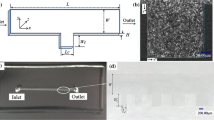Abstract
A numerical simulation methodology for ultrasonic particle/cell separation and cell washing processes is introduced and validated by comparing with the results from the literature. In this study, a finite element approach is used for modeling fluid flow in a microchannel and analytical relations are utilized for the calculation of the ultrasonic radiation forces. The solutions in acoustic and fluidic domains are coupled, and the particle separation under the influence of ultrasonic waves is numerically simulated. In order to simulate the cell washing process, diffusion and fluid dynamics solutions are coupled and solved. A Monte Carlo approach is chosen where statistical distributions are implemented in the simulations. Uniform distributions for the starting locations of particles/cells in the microchannel and normal distributions for the size of the particles are used in numerical simulations. In each case, 750 particles are used for the simulation, and the performance of separation process is evaluated by checking how many microparticles resulted in the targeted outlet channels. Channel geometries for the numerical simulations are adapted from the experimental studies in literature, and comparison between the reported experimental results and the numerical estimations is performed. It has been observed that the numerical estimations and experimental results from the literature are in good agreement, and the proposed methodology may be implemented as a design tool for ultrasonic particle manipulation for microfluidic applications.











Similar content being viewed by others
References
Adams JD, Soh HT (2010) Tunable acoustophoretic band-pass particle sorter. Appl Phys Lett 97
Bazou D, Castro A, Hoyos M (2012) Controlled cell aggregation in a pulsed acoustic field. Ultrasonics 52(7):842–850
Bhagat lAAS, Papautsky I, (2008) Enhancing particle dispersion in a passive planar micromixer using rectangular obstacles. J Micromech Microeng 18:1–9
Dron O, Ratier C, Hoyos M, Aider J-L (2009) Parametric study of acoustic focusing of particles in a micro-channel in the perspective to improve micro-PIV measurements. Microfluid Nanofluid 7:857–867
Evander M, Johansson L, Lilliehorn T, Piskur J, Lindvall M, Johansson S, Almqvist M, Laurell T, Nilsson J (2007) Noninvasive acoustic cell trapping in a microfluidic perfusion system for online bioassays. Anal Chem 79:2984–2991
Glynne-Jones P, Mishra PP, Boltryk RJ, Hill M (2013) Efficient finite element modeling of radiation forces on elastic particles of arbitrary size and geometry. J Acoust Soc Am 133:1885–1893
Gorkov LP (1962) On the forces acting on a small particle in an acoustic field in an ideal fluid. Sov Phys Doklady 6:773–776
Gralinski I, Alan T, Neild A (2012) Non-contact acoustic trapping in circular cross-section glass capillaries: a numerical study. J Acoust Soc Am 132:2978–2987
Haake A, Neild A, Kim D, Ihm J, Sun Y, Dual J, Ju B (2005) Manipulation of cells using an ultrasonic pressure field. Ultrasound Med Biol 31:857–864
Hawkes JJ, Barrow D, Coakley WT (1998) Micro-particle manipulation in millimetre scale ultrasonic standing wave chambers. Ultrasonics 36:925–931
Hawkes JJ, Barber RW, Emerson DR, Coakley WT (2004) Continuous cell washing and mixing driven by an ultrasound standing wave within a microfluidic channel. Lab Chip 4:446–452
Johnson DA, Feke DL (1995) Methodology for fractionating suspended particles using ultrasonic standing wave and divided flow fields. Separ Technol 5:251–258
Kumar M, Feke DL, Belovich JM (2005) Fractionation of cell mixtures using acoustic and laminar flow fields. Biotechnol Bioeng 89. doi:10.1002/bit.20294
Limaye S, Coakley WT (1998) Clarification of small volume microbial suspensions in an ultrasonic standing wave. J Appl Microbiol 84:1035–1042
Martinez-Duarte R, Gorkin RA III, Abi-Samra K, Madou MJ (2010) The integration of 3D carbone-electrode dielectrophoresis on a CD-like centrifugal microfluidic platform. Lab Chip 10:1030–1043
Nam J, Lee Y, Shin S (2011) Size-dependent microparticles separation through standing surface acoustic waves. Microfluid Nanofluid 11:317–326
Neild A, Oberti S, Haake A, Dual J (2006) Finite element modeling of a micro-particle manipulator. Ultrasonics 44:455–460
Neild A, Oberti S, Dual J (2007) Design, modeling and characterization of microfluidic devices for ultrasonic manipulation. Sens Actuators B 121:452–461
Petersson F, Nilsson A, Holm C, Jnsson H, Laurell T (2005a) Continuous separation of lipid particles from erythrocytes by means of laminar flow and acoustic standing wave forces. Lab Chip 5:20–22
Petersson F, Nilsson A, Jonsson H, Laurell T (2005b) Carrier medium exchange through ultrasonic particle switching in microfluidic channels. Anal Chem 77:1216–1221
Petersson F, Berg LA, Sward-Nilsson A, Laurell T (2007) Free flow acoustophoresis: microfluidic-based mode of particle and cell separation. Anal Chem 79:5117–5123
Settnes M, Bruus H (2012) Forces acting on a small particle in an acoustic field in a viscous fluid. Phys Rev E 85
Shi J, Huang H, Stratton Z, Huang Y, Huang TJ (2009) Continuous particle separation in a microfluidic channel via standing surface acoustic waves (SSAW). Lab Chip 9:3354–3359
Smith DM, Wiggins TA (1972) Sound speeds and laser induced damage in polystyrene. Appl Optics 11:2681
Townsend RJ, Hill M, Harris NR, White NM (2004) Modeling of particle paths passing through an ultrasonic standing wave. Ultrasonics 42:319–324
Tripp G, Ventikos Y, Taggart DP, Coussios C-C (2011) CFD modeling of an ultrasonic separator for the removal of lipid particles from pericardial suction blood. IEEE Trans Biomed Eng 58:282–290
Trujillo FJ, Eberhardt S, Möller D, Dual J, Knoerzer K (2013) Multiphysics modelling of the separation of suspended particles via frequency ramping of ultrasonic standing waves. Ultrason Sonochem 20:655–666
Yosioka K, Kawasima Y (1955) Acoustic radiation pressure on a compressible sphere. Acoustica 5:167–173
Acknowledgments
Financial support from the Turkish Scientific and Technical Research Council, Grant No. 112M102, is greatly appreciated.
Author information
Authors and Affiliations
Corresponding author
Rights and permissions
About this article
Cite this article
Büyükkoçak, S., Özer, M.B. & Çetin, B. Numerical modeling of ultrasonic particle manipulation for microfluidic applications. Microfluid Nanofluid 17, 1025–1037 (2014). https://doi.org/10.1007/s10404-014-1398-7
Received:
Accepted:
Published:
Issue Date:
DOI: https://doi.org/10.1007/s10404-014-1398-7




